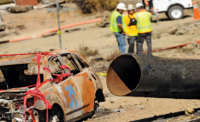...as long as the certification meets standards of independent accrediting bodies. That provision will reduce employers’ costs and also get some operators on the job sooner than if they had to pass another certification test.
OSHA’s Michaels says that other crane-related workers, including riggers, will have to be “qualified” for their tasks. He also says another change from the agency’s 2008 proposed rule is that the final regulation clarifies that OSHA’s rules “do not preempt state and local requirements.”
The regulation includes new mandatory procedures for working around power lines and provisions dealing with synthetic slings, a product that he says was not in use 40 years ago. Michaels says the new rule requires synthetic slings to be used in accordance with manufacturers’ instructions, during assembly and disassembly. In addition, tower-crane parts will have to be inspected before the crane is erected.
The regulation also specifies that the “controlling entity” on a job site—such as the prime or general contractor or construction manager—is responsible for ensuring ground conditions are firm and for notifying the crane operator or user of any known hazards under the equipment set-up area.
Questions Remain
The rule has been long in the works. OSHA decided to use a “negotiated rulemaking” approach and, in 2003, assembled a 23-member advisory committee, composed of representatives from various parts of the industry and from labor unions. The committee reached a consensus on crane regulatory provisions in July 2004.
But a formal proposed rule didn’t come out until October 2008. The final rule was issued about 21 months after that proposal was published.
With such an extensive regulation, it’s no surprise that industry has questions. An OSHA Web discussion on July 28 drew several hundred questions from participants.
Kevin Cannon, the Associated General Contractors’ director of safety and health services, says, “There are a lot of provisions in the rule that may need to be addressed by way of ‘letter of interpretation’ [from OSHA] to clarify some of the confusion.” One area that may need clarification is whether the employer-paid “cost” of operator certification includes items beyond the course itself, such as workers’ time away from the job to take the course.
OSHA says that it will have follow-up “compliance assistance material” ready by late August.



Post a comment to this article
Report Abusive Comment